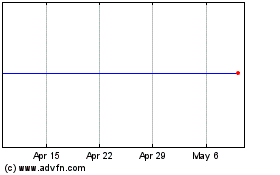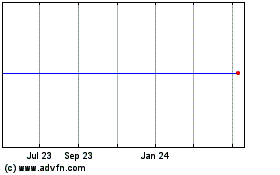Ocata Therapeutics Receives Three New U.S. Patents for its RPE Therapy for Macular Degenerative Diseases
May 26 2015 - 8:54AM
Business Wire
Patent Portfolio Expanded to Cover RPE Products
from All Pluripotent Stem Cell Sources
Ocata Therapeutics, Inc. (“Ocata” or “the Company”; NASDAQ:
OCAT), a leader in the field of Regenerative Ophthalmology™,
today announced that the United States Patent and Trademark Office
(USPTO) issued three new U.S. Patents, Nos. 9,040,770, 9,040,039
and 9,040,038, which expand the scope of protection of the four
previously issued U.S. patents covering its retinal pigment
epithelium (RPE) transplant technology. These three new patents
extend protection to include all formats and formulations of RPE
cells, including suspensions and sheets of cells, for use as
therapeutic agents, and the use of these formulations for treating
ophthalmic diseases such as dry age related macular degeneration
(Dry AMD) and Stargardt’s macular degeneration (SMD).
"We believe that these three new patents are especially
important as they extend our patent estate to include not only
hESC-derived RPE, but also all products derived from iPSC sources.
This broadening of the patent estate could also prove to be highly
valuable in the long-term as we develop next generation therapies,”
said Paul K. Wotton, President and Chief Executive Officer of Ocata
Therapeutics. “Ocata continues to distinguish itself not only as
the leader in Regenerative Ophthalmology, but also as a leader in
manufacturing cell therapies from pluripotent stem cells and in the
clinical development of such proprietary therapies.”
Ocata has a total of seven U.S. patents that specifically
protect retinal pigmented epithelial (RPE) products derived from
human embryonic stem cells (hESC) as well as any other pluripotent
stem cell source including induced pluripotent stem cell (iPSC)
sources.
“These new patents bolster an already robust patent estate. This
is important as we continue to invest in the clinical development
of these innovative new therapies for macular degeneration,” said
Dr. Eddy Anglade, Chief Medical Officer of Ocata. “For the first
time a pluripotent stem cell derived therapy is about to enter a
pivotal trial for Stargardt’s Disease and phase 2 clinical trials
for dry Age Related Macular Degeneration, bringing the possibility
of these long awaited therapies that much closer to reality.”
About Ocata Therapeutics, Inc.
Ocata Therapeutics, Inc. is a clinical stage biotechnology
company focused on the development and commercialization of
Regenerative Ophthalmology therapeutics. Ocata’s most advanced
products are in clinical trials for the treatment of Stargardt’s
macular degeneration, dry age-related macular degeneration, and
myopic macular degeneration. Ocata’s intellectual property
portfolio includes pluripotent stem cell platforms – hESC and
induced pluripotent stem cell (iPSC) – and other cell therapy
research programs. For more information, visit www.ocata.com.
About Age-related Macular Degeneration
Age-related macular degeneration is the leading cause of vision
loss in people over the age of 50. Every year in the USA there are
1.8 million patients newly diagnosed with dry AMD which occurs when
light-sensitive photoreceptor cells in the macula, located in the
center of the retina, slowly break down, causing vision loss as a
result. Photoreceptor breakdown is a consequence of loss or damage
to the RPE layer. As the disease progresses, patients may have
difficulty reading and recognizing faces. There is currently no
proven medical therapy for dry AMD and the projected number of
people worldwide with age-related macular degeneration in 2020 is
196 million, increasing to 288 million in 2040 underscoring the
urgent need for new treatments.
About Stargardt’s Disease
Stargardt’s macular degeneration is a form of juvenile macular
degeneration that affects vision in children and young adults
between the ages of six and 20, with a prevalence of approximately
one in 10,000 people in the United States. It is an orphan disease
and loss of vision is an inevitable aspect of SMD, with more than
half of the patients experiencing vision loss in the range of
20/200-20/400. Like dry AMD, it occurs as a result of damage to the
RPE layer and there are no treatments currently approved to prevent
or slow the vision loss associated with SMD.
Forward-Looking Statements
All statements, other than historical facts, contained in this
news release, including statements regarding, Ocata’s beliefs
regarding the scope of protection provided by and the long-term
value of its new and existing patents, the effect of such patents
on the Ocata’s clinical development plans, the timing of a proposed
pivotal trial for Stargardt’s Disease and phase 2 clinical trials
for dry Age Related Macular Degeneration, and any other statements
about Ocata’s future expectations, beliefs, goals, plans, results
or prospects expressed by management constitute forward-looking
statements within the meaning of the Private Securities Litigation
Reform Act of 1995. Any statements that are not statements of
historical fact (including statements containing the words “will,”
“believes,” “plans,” “anticipates,” “expects,” “estimates,” and
similar expressions) should also be considered to be
forward-looking statements. There are a number of important factors
that could cause actual results or events to differ materially from
those indicated by such forward-looking statements, including: the
fact that Ocata has no product revenue and no products approved for
marketing; Ocata’s limited operating history; Ocata’s need for and
limited sources of future capital; potential failures or delays in
obtaining regulatory approval of products; risks inherent in the
development and commercialization of potential products; reliance
on new and unproven technology in the development of products; the
need to protect Ocata’s intellectual property; the challenges
associated with conducting and enrolling clinical trials; the risk
that the results of clinical trials may not support Ocata’s product
candidate claims; the risk that physicians and patients may not
accept or use Ocata’s products, even if approved; Ocata’s reliance
on third parties to conduct its clinical trials and to formulate
and manufacture its product candidates; and economic conditions
generally. Additional information on potential factors that could
affect our results and other risks and uncertainties are detailed
from time to time in Ocata’s periodic reports, including the Annual
Report on Form 10-K for the fiscal year ended December 31, 2014.
Forward-looking statements are based on the beliefs, opinions, and
expectations of Ocata’s management at the time they are made, and
Ocata does not assume any obligation to update its forward-looking
statements if those beliefs, opinions, expectations, or other
circumstances should change. Forward-looking statements are based
on the beliefs, opinions, and expectations of Ocata’s management at
the time they are made, and Ocata does not assume any obligation to
update its forward-looking statements if those beliefs, opinions,
expectations, or other circumstances should change. There can be no
assurance that Ocata’s future clinical trials will be successful or
that the results of previous clinical studies will lead to
commercialization or products or therapies.
View source
version on businesswire.com: http://www.businesswire.com/news/home/20150526005599/en/
Ocata Therapeutics, Inc.Investors:Westwicke PartnersJohn
Woolford, 443-213-0506john.woolford@westwicke.comorPress:Russo
PartnersDavid Schull,
858-717-2310david.schull@russopartnersllc.com
Ocata Therapeutics, Inc. (NASDAQ:OCAT)
Historical Stock Chart
From Mar 2024 to Apr 2024

Ocata Therapeutics, Inc. (NASDAQ:OCAT)
Historical Stock Chart
From Apr 2023 to Apr 2024
